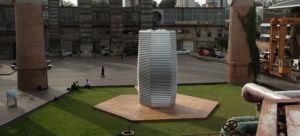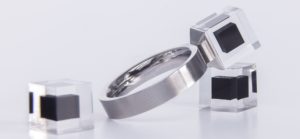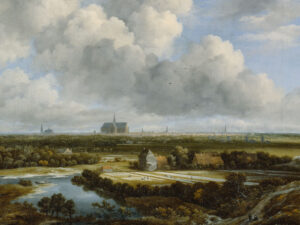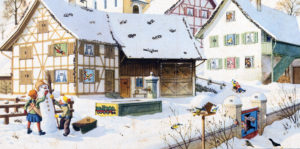
Smog Free Ring
Jewellery made of smog that contributes to clean air? The Dutch artist Daan Roosegarde makes it possible thanks to his ingenious and unique concept.
The title of this ring designed and created by Dutch artist Daan Roosegarde and his team of designers in the Studio Roosegarde in Rotterdam appears rather puzzling. Jewels are rarely associated with environmental topics, but the story behind this unusual object is all the more intriguing and may point to jewels of the future, at least in an ideal world. Today society is becoming increasingly aware of the fragility and importance of the environment and the responsibilities of our legacy for generations to come. Global warming, free trade and sustainability are possibly the most common terms that are linked with this ethical issue. In fact, such subjects are more related to nature and its forces, architectural concepts and objects used in our everyday life, less so with a form of adornment, such as jewellery or even a decorative ring worn on the finger.
The Alice and Louis Koch Collection of nearly 2600 finger rings, today in the Swiss National Museum, Zurich, has its origins in the early 20th century and has been handed down within the family for over 100 years. Successive generations contributed to the collection in different ways. In the past 20 years, however, it was the fourth generation of the family who decided to expand the collection into the 20th and 21st century. Nearly 600 examples of this period by artist jewellers from around the world document daring designs, modern concepts of traditional craftsmanship, the development of new materials and modern day technology in the making of the rings. The collection embraces new artistic developments in contemporary jewellery, but also current themes. An early acquisition before 1994 included a ring made of recycled washing up bottles by Beate Leinz from Germany, when the discussion on sustainability was not as widespread as today, and certainly not in the field of jewellery.

The "Smog Free Tower" in Beijing. Photo: Derrick Wang
For this reason it may not be surprising that more recently the “Smog Free Ring” made by the Dutch artist and innovator Daan Roosegaarde of Studio Roosegaarde in Rotterdam was acquired for the Alice and Louis Koch Collection. The bezel of the ring consists of a glass cube which contains smog from Beijing which was collected from the Smog Free Tower. The latter is an award-winning construction created by Studio Roosegarde and supported by the Chinese government. It is a seven metre high air purifier in hexagonal form which has been described as the “largest electronic smog vacuum cleaner”. The exterior consists of silver plates – resembling Venetian blinds – and within is the air purifier based on patented ionization technology. The Smog Free Tower cleans up to 30.000 m3 per hour, runs on green energy and has the capability of making the air up to 75 % cleaner. During this process the purifier filters and compresses the smog in the surrounding area, enough to form every day a handful of cubes.

The "Smog Free Ring". Photo: Studio Roosegaarde
It is such a cube with compressed smog particles that is integrated in the ring and at the same time forms a decorative element to this individually crafted object. The wearer, either he or she, owns a well-designed and unique jewel, and at the same time makes an important contribution to the environment by donating 1000 m3 clean air. From a jewellery historical viewpoint it is an irony that the substance collected from the Smog Free Tower contains according to the science behind the Studio Roosegaarde team about 42% carbon, and diamonds which over centuries have been the highly prized objects of desire, also described as “the girls’ best friend”, in essence are composed of carbon. The glass cube with the smog carbon inlay may not be a substitute for sparkly diamonds which refract light, but it may be a look to the future, for those who wish to save the planet and its resources. The owner wears this modern design with pride, and in keeping with the tradition of jewellery sends out a message, act against pollution.
In recent decades artist jewellers have used recycled materials to create artistic contemporary jewellery, such as Peter Chang from the United Kingdom using recycled plastics for his opulent bangles, in Switzerland Verena Sieber-Fuchs with egg cartons, coffee cream lids, butcher’s papers creating soft flowing necklaces, Julia Manheim in London meshes the Guardian newspaper with wire or discarded Nespresso capsules are combined with precious metals to form intricate jewellery by Nolia Shakti from the Czech Republic. Rosalie McMillan in London makes luxury jewellery from Çurface, a material derived from coffee grounds. Much like the Smog Free Ring, these artist jewellers and designers are pointing to the thoughtless waste in our society and how this can be transformed into fascinating creations to wear.
Ethically sourced materials for jewellery are becoming ever more in demand, diamonds, emeralds, rubies or other gemstones require certificates of origin. Many jewellers, like Ute Decker in London, emphasise the sole use of fairtrade gold and silver in their art work.
The “Smog Free Ring” is fun to wear, but at the same time a reminder how we as wearers can contribute to protect our living environment and gives us food for thought about the value of a jewel. Art and science are joined together to make a better world.
Official project video by Studio Roosegaarde
Jewellery. materials craft art
19. May – 22. October
National Museum Zurich
Whether as a ritual, ornament, decoration, memento or status symbol, people have always made jewellery from a vast range of materials. This exhibition at the National Museum Zurich highlights aspects of jewellery manufacture and presents jewellery in its context of love, rebellion or tradition. A separate room is dedicated to jewellery of the 20th century, from Lalique to Max Bill and right through to contemporary jewellery artists like Bernhard Schobinger and Johanna Dahm.



